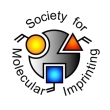Authors: Ghai M, Narula P, Kaur V, Singh R
Article Title: Imprinted silica nanoparticles coated with N-propylsiliylmorpholine-4-carboxamide for the determination of m-cresol in synthetic and real samples.
Publication date: 2015
Journal: Journal of Separation Science
Page numbers: n/a.
DOI: 10.1002/jssc.201500475
Abstract: m-cresol-imprinted silica nanoparticles coated with N-propylsilylmorpholine-4-carboxamide have been developed that contain specific pockets for the selective uptake of m-cresol. Silica nanoparticles were synthesized by a sol-gel process followed by functionalization of their surface with N-propylsilylmorpholine-4-carboxamide. The formation of m-cresol-imprinted silica nanoparticles was confirmed by UV-Vis spectrophotometry, infrared spectroscopy, thermogravimetric analysis, scanning electron microscopy and transmission electron microscopy. Electron microscopic studies revealed the formation of monodispersed imprinted silica nanoparticles with spherical shape and an average size of 83 nm. The developed nanoparticles were filled in a syringe and used for the extraction of m-cresol from aqueous samples followed by quantification using high-performance liquid chromatography with diode array detection. Various adsorption experiments showed that developed m-cresol-imprinted silica nanoparticles exhibited a high adsorption capacity and selectivity and offered a fast kinetics for rebinding m-cresol. The chromatographic quantification was achieved using mobile phase consisting of acetonitrile/water (70:30 v/v) at an isocratic flow rate of 1.0 mL/min using a reversed-phase C18 column and detection at λmax = 275 nm. The limits of detection and quantification were 1.86and 22.32 ng mL-1,respectively, for the developed method. The percent recoveries ranged from 96.66-103.33% in the spiked samples. This combination of this nanotechnique with molecular imprinting was proved as a reliable, sensitive and selective method for determining the target from synthetic and real samples. This article is protected by copyright. All rights reserved
Author keywords: m-cresol, endocrine disruptors, Molecularly imprinted silica nanoparticles, N-propylsilylmorpholine-4-carboxamide



Join the Society for Molecular Imprinting

New items RSS feed
Sign-up for e-mail updates:
Choose between receiving an occasional newsletter or more frequent e-mail alerts.
Click here to go to the sign-up page.
Is your name elemental or peptidic? Enter your name and find out by clicking either of the buttons below!
Other products you may like:
 MIPdatabase
MIPdatabase









